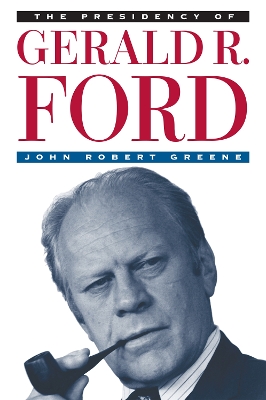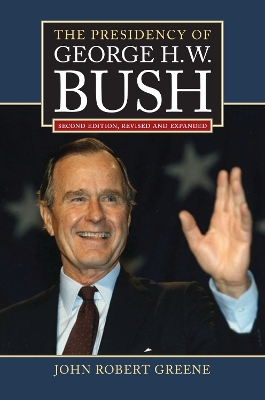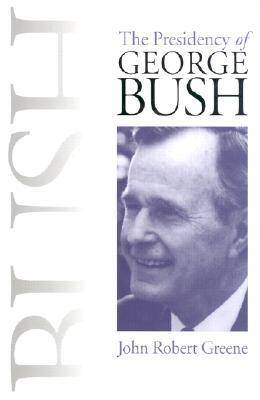American Presidency
3 total works
This is a study of one of the most popular yet most misunderstood presidents. Reaching beyond the image of Ford as ""healer"" of a war-torn and scandal-ridden nation, the author aims to extend and revise our understanding of Ford's struggles to restore credibility to the presidency in the wake of Watergate and Vietnam.Few presidents have ever be en asked to achieve so much in so little time against such great adversity. Greene shows that Ford's efforts to lead the nation were severely hampered by Nixon's misdeeds, by America's ignominious disengagement from an unpopular war, and by a watchdog Congress eager to put a brake on presidential power. Working from recently declassified documents, Greene reveals evidence on Ford's roles in Watergate and challenges the prevailing view of the infamous ""Mayaguez"" incident. He argues that Ford made no ""deal"" with Nixon, but that his pardon of Nixon was costly nevertheless, for it shadowed his entire presidency thereafter. Greene also shows that the ""Mayaguez"" catastrophe was less a simple ""rescue mission"" than it was an attempt to revive sagging political fortunes by attacking Cambodia. In addition, Greene details Ford's rise to prominence within the Republican Party; chronicles the president's problematic relations with his staff, the new Democratic Congress, and Ronald Reagan; sheds light on the selection and performance of Vice-President Nelson Rockefeller; offers insights into the election of 1976; and provides a look at Ford's Amnesty Programme for Vietnam era draft evaders. Based on interviews with Ford and more than 60 individuals who figured prominently in his presidency and on extensive use of the Ford Library, Greene's study covers Ford's valiant efforts during some of the presidency's most troubled years.
Shortly after George H. W. Bush lost his re-election bid to Bill Clinton in 1989, John Robert Greene’s verdict on the 41st president of the United States was that he “brought no discredit to the office” and “Bush was both patient and prudent. . . mak[ing] few mistakes.” In the years since the release of Greene’s profile of the senior Bush, deemed by Publishers Weekly, “the essential introduction to Bush’s abbreviated, but still consequential, tenure in office,” a wealth of materials about Bush’s presidency has become available, even as distance has sharpened our perspective on the Bush years. In this significantly expanded second edition of The Presidency of George H.W. Bush, Greene takes full advantage of newly released documents to revisit Bush’s term, to consider his post-presidency accomplishments, and to enhance and clarify our understanding of his place in history.
Such milestones as the fall of the Berlin Wall, the reunification of Germany, the fall of the Soviet Union, the savings and loan crisis, and the transition to the Clinton administration receive renewed and far more detailed treatment here, as do the ramifications of George H. W. Bush’s positions and policies. Greene also devotes ample attention to Bush’s post-presidency, including his relationship with his son, President George W. Bush, as well as the development of his close friendship with Bill Clinton. The elder Bush emerges from this reappraisal as a considerably more activist president, with a more activist administration, than was previously assumed. Greene’s concise and readable account, drawing on the contents of the Bush Library, the papers of James A. Baker III, and personal interviews, shows us the 41st president—and thus an important chapter in American history—in a new and more revealing light.
Such milestones as the fall of the Berlin Wall, the reunification of Germany, the fall of the Soviet Union, the savings and loan crisis, and the transition to the Clinton administration receive renewed and far more detailed treatment here, as do the ramifications of George H. W. Bush’s positions and policies. Greene also devotes ample attention to Bush’s post-presidency, including his relationship with his son, President George W. Bush, as well as the development of his close friendship with Bill Clinton. The elder Bush emerges from this reappraisal as a considerably more activist president, with a more activist administration, than was previously assumed. Greene’s concise and readable account, drawing on the contents of the Bush Library, the papers of James A. Baker III, and personal interviews, shows us the 41st president—and thus an important chapter in American history—in a new and more revealing light.
How could a president have won a war and lost an electon? For George Bush, being Commander in Chief during Desert Storm was not enough. Domestic issues, personality factors and the vagaries of the 1992 campaign confined his presidency to a single term. John Robert Greene helps us understand why. This history of George Bush's administration paints a portrait of a "positive moderate" whose acomplishments are often underrated. The book makes use of a range of literature on the forty-first president - including the Bush Papers at the George Bush Presidential Library at Texas A&M University - and draws on key interviews with members of his administration, and with George Bush himself. Greene sets Bush's presidency in the context of the Reagan years and reviews not only his foreign policy successes, notably the war with Iraq and an improved relationship with Russia, but also key domestic issues such as the economic recession, the much maligned "Read My Lips" tax hike, Clarence Thomas's controversial Supreme Court appointment, and the enactment of bills that protected the environment and improved the lives of disabled Americans.
The author offers an analysis of Bush's bid for re-election, describing a campaign that saw conservatives abandoning Bush in droves while early signs of an economic upturn did little to defuse the Democrats' advantage. The book depicts the president as a man of patience and prudence, who placed great value on loyalty, and was better at managing crises than he was the day-to-day demands of the presidency. It portrays the sense of humour and love of the outdoors in a man often branded an elitist or a wimp, who was never able to ultimately manipulate his public image to his advantage. "The Presidency of George Bush" takes into account the many facets of the Bush administration, from the spirited optimism of a thousand points of light to the unsettling vagueness of "the vision thing", and shows us a man whose careful stewardship set the tone for post-Cold War foreign policy. As Greene notes, while Bush had his critics, it was on his watch that the Cold War ended and America re-asserted its military might.
The author offers an analysis of Bush's bid for re-election, describing a campaign that saw conservatives abandoning Bush in droves while early signs of an economic upturn did little to defuse the Democrats' advantage. The book depicts the president as a man of patience and prudence, who placed great value on loyalty, and was better at managing crises than he was the day-to-day demands of the presidency. It portrays the sense of humour and love of the outdoors in a man often branded an elitist or a wimp, who was never able to ultimately manipulate his public image to his advantage. "The Presidency of George Bush" takes into account the many facets of the Bush administration, from the spirited optimism of a thousand points of light to the unsettling vagueness of "the vision thing", and shows us a man whose careful stewardship set the tone for post-Cold War foreign policy. As Greene notes, while Bush had his critics, it was on his watch that the Cold War ended and America re-asserted its military might.


